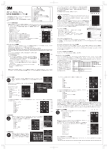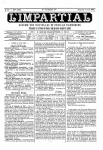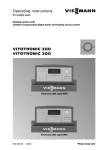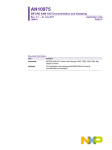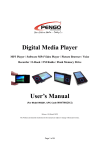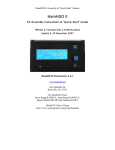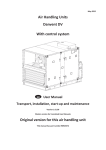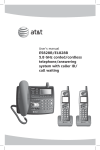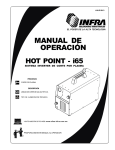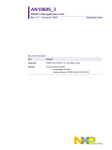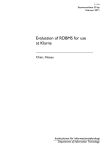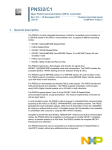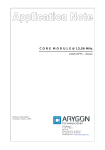Download fulltext - DiVA Portal
Transcript
NFC-Enable System Design in Wireless Sensor
Network
YIN HUA
Master’s Thesis at iPack Center, KTH
Supervisor: Qiang Chen, Zhibo Pang
Examiner: Prof. Lirong Zheng
January 2013
iii
Abstract
Wireless Sensor Network (WSN) have the potential to greatly affect every
part of industrial and people’s lifestyle. For this reason, iPack VINN Excellence
Center contributes to wireless tracking platform for fresh food and lifestyle.
Every new idea or technology is attempted to integrate to the WSN for more
efficient, better user experience and lower power consumption. Meanwhile Near
Field Communication (NFC), a short-range wireless connectivity technology,
which can make communication easily,safety and intuitively arousing iPack
interest. So this master thesis focus on integrating NFC technology into existing
systems to build a NFC-enable Wireless Sensor Network system. And with this
system, only one simple touch, data from sensor node can be transmitted to
mobile phone or tablet. Furthermore parameters of sensor node also can be
configured easily by using above devices. So basically the NFC peer-to-peer
communication protocol is mainly used. To implement and test the functions
of the demonstration, a sets of hardware is needed to chosen and bought.
How to design the system without changing old WSN is very tricky. To
design a NFC adapter which can connect existing WSN with NFC part is the
solution of this thesis. So the main task was designing a NFC adapter which
could be connected with either mobile phone/tablet or sensor node. It was the
NFC adapter that makes mobile phone/tablet or sensor node NFC enabled. For
the connection method, the high speed UART interface was chosen to connect
with sensor node. The architecture of NFC adapter includes two main parts, A
NFC chip (PN532) from NXP and a MCU(VNC2) from FTDI. The PN532 uses
its antenna to send or receive data with different NFC protocols. The VNC2
is used to store sensor collected data and sends command though UART to
control the PN532.
Learning to use the PN532 was a tough task during the thesis work. Both
official manuals and demo application are helpful for understanding the PN532
controlling. In addition, We analysed the sniffer data from demo application
and code from NXP software design kit (SDK). which helped us to know the
process of the PN532 peer-to-peer communication. After learning from official application, user manual and monitoring software/hardware design kid
applications, we began to design our own hardware suitable SDK for the NFC
adapter. At first we connected the hardware parts. When hardware connection
was ready, we wrote and tested the firmware for VNC2 platform. Then due to
the reason that Windows is more stable than our build VNC2 platform system
at that moment, we wrote our own software design kid for NFC adapter under
Windows OS first. The basic idea of software design kid is easy to use, modify and integrate into any other platforms. At the end of the thesis project,
we integrated our own SDK into VNC2. When integration was done, a lot of
stability and performance validation were done. Based on the result of testing,
we optimized and modified our SDK and tested it again.
This thesis project basically handles out a new ideal of integrating NFC to
existing wireless sensor network to make WSN NFC enable. To prove the idea,
we made a demo to show the enhanced sensor node and the results are satisfied.
However there still has a lot of works and a lot of improvement should can be
done in the future.
Keywords:Near Field Communication; Wireless Sensor Network; peer-to-peer;
NFC enable; PN532; VNC2.
Contents
Contents
iv
1 Introduction
1.1 Motivation . . . . . . . . . . . . . . . . . . . . . . . . . . . . . . . .
1.2 Outline of the Thesis Report . . . . . . . . . . . . . . . . . . . . . .
1
1
2
I Background Study
3
2 Basic Knowledge
2.1 NFC Technology Roadmap . . . . . . . .
2.1.1 ISO 14443-A/B, FeliCa . . . . . .
2.1.2 ISO/IEC 18092 or ECMA-340 . .
2.1.3 Working Mode . . . . . . . . . . .
2.2 The Comparative on wireless transmission
2.2.1 Bluetooth2.1 . . . . . . . . . . . .
2.2.2 ZigBee . . . . . . . . . . . . . . . .
2.2.3 802.11(WiFi) . . . . . . . . . . . .
2.2.4 IrDa . . . . . . . . . . . . . . . . .
.
.
.
.
.
.
.
.
.
.
.
.
.
.
.
.
.
.
.
.
.
.
.
.
.
.
.
.
.
.
.
.
.
.
.
.
.
.
.
.
.
.
.
.
.
.
.
.
.
.
.
.
.
.
.
.
.
.
.
.
.
.
.
.
.
.
.
.
.
.
.
.
.
.
.
.
.
.
.
.
.
.
.
.
.
.
.
.
.
.
.
.
.
.
.
.
.
.
.
.
.
.
.
.
.
.
.
.
.
.
.
.
.
.
.
.
.
5
5
5
5
6
7
7
8
8
8
3 Project Environment
3.1 Hardware Environment . . . . . . . . . . . . .
3.1.1 Tablet with NFC Chip . . . . . . . . . .
3.1.2 NFC Adapter . . . . . . . . . . . . . . .
3.1.3 PN532 features and benefits . . . . . . .
3.1.4 PN532 Demo Board . . . . . . . . . . .
3.1.5 Galaxy Tab . . . . . . . . . . . . . . . .
3.1.6 slave node(MSP430) . . . . . . . . . . .
3.1.7 FTDI VNC . . . . . . . . . . . . . . . .
3.2 Software Environment . . . . . . . . . . . . . .
3.2.1 PC RS232 COM port programme IDE .
3.2.2 Serial port Monitor and Sniffer Software
3.2.3 VNC2 IDE . . . . . . . . . . . . . . . .
.
.
.
.
.
.
.
.
.
.
.
.
.
.
.
.
.
.
.
.
.
.
.
.
.
.
.
.
.
.
.
.
.
.
.
.
.
.
.
.
.
.
.
.
.
.
.
.
.
.
.
.
.
.
.
.
.
.
.
.
.
.
.
.
.
.
.
.
.
.
.
.
.
.
.
.
.
.
.
.
.
.
.
.
.
.
.
.
.
.
.
.
.
.
.
.
.
.
.
.
.
.
.
.
.
.
.
.
.
.
.
.
.
.
.
.
.
.
.
.
.
.
.
.
.
.
.
.
.
.
.
.
.
.
.
.
.
.
.
.
.
.
.
.
9
9
9
9
13
14
15
16
17
18
18
19
20
iv
.
.
.
.
.
.
.
.
.
.
.
.
.
.
.
.
.
.
CONTENTS
v
II NFC Adapter Implementation
4 Four Ways Implementation Trade
4.1 Libnfc . . . . . . . . . . . . . . .
4.2 NFC-FRI SDK integrate . . . . .
4.3 Porting NFC HAL Software . . .
4.4 Sniffer and Write own SDK . . .
21
Off
. . .
. . .
. . .
. . .
.
.
.
.
.
.
.
.
.
.
.
.
.
.
.
.
.
.
.
.
.
.
.
.
.
.
.
.
.
.
.
.
.
.
.
.
.
.
.
.
.
.
.
.
.
.
.
.
23
23
23
24
26
5 How to Use The PN532 Command
5.1 PN532 host link protocol . . . . . . . . . . . . .
5.1.1 Normal and Extended Information Frame
5.1.2 ACK Frame and NACK Frame . . . . . .
5.1.3 Error Frame . . . . . . . . . . . . . . . . .
.
.
.
.
.
.
.
.
.
.
.
.
.
.
.
.
.
.
.
.
.
.
.
.
.
.
.
.
.
.
.
.
.
.
.
.
.
.
.
.
.
.
.
.
29
29
30
30
31
.
.
.
.
.
.
.
.
.
.
.
.
.
.
33
33
34
35
35
37
37
37
39
41
41
41
44
46
47
.
.
.
.
.
.
.
.
.
.
.
.
.
.
.
.
.
.
.
.
6 Implement Application on VNC
6.1 Connection of Hardware . . . . . . . . . . . . . . . . . . .
6.1.1 Additional Lines–IRQ(DTR) and HREQ(DSR) . .
6.2 Application Code . . . . . . . . . . . . . . . . . . . . . . .
6.2.1 Low Power mode and Wake up . . . . . . . . . . .
6.2.2 Baud Rate Setting . . . . . . . . . . . . . . . . . .
6.2.3 As a NFC Target setting . . . . . . . . . . . . . .
6.2.4 As a NFC Initiator setting . . . . . . . . . . . . .
6.2.5 Data Exchange . . . . . . . . . . . . . . . . . . . .
6.2.6 Overview of our own developing NXP PN532 SDK
6.3 SDK Integrated Into VNC . . . . . . . . . . . . . . . . . .
6.3.1 VNC firmware code . . . . . . . . . . . . . . . . .
6.3.2 Integrated . . . . . . . . . . . . . . . . . . . . . . .
6.3.3 testing and optimize . . . . . . . . . . . . . . . . .
6.3.4 Final Demonstration . . . . . . . . . . . . . . . . .
.
.
.
.
.
.
.
.
.
.
.
.
.
.
.
.
.
.
.
.
.
.
.
.
.
.
.
.
.
.
.
.
.
.
.
.
.
.
.
.
.
.
.
.
.
.
.
.
.
.
.
.
.
.
.
.
.
.
.
.
.
.
.
.
.
.
.
.
.
.
IIIConclusion and Future Work
49
7 Conclusion
7.1 Overview of The Thesis Work . . . . . . . . . . . . . . . . . . . . . .
51
51
8 Future Work
8.1 Support SPI and I2C Interface . . . . . . . . . . . . . . . . . . . . .
8.2 Improve and Optimize SDK Code . . . . . . . . . . . . . . . . . . . .
8.3 communicate directly with NFC-enable tablet . . . . . . . . . . . . .
53
53
53
53
Reference
55
Chapter 1
Introduction
Wireless sensor network (WSN) consists of spatially distribute autonomous sensors
to monitor physical or environment conditions. WSN is built of nodes which are
used to collect data such as temperature, pressure, motion and pollutants, passing
through the network to the main server. The development of WSN was motivated
by military demanding, and today such networks are used in many industrial and
consumer applications, such as fresh food tracking, Patient health monitoring and
industrial process monitoring.
iPack Center, Royal Institute of Technology (KTH), Sweden contributes to WSN
system developing and innovation. The iPack Center is focus on designing a wireless
tracking and communication platform.[1] In case to save the cost and power consumption the WAN-SAN Coherent Architecture with a dual-layer wireless topology
is used. The topology includes three main parts, wireless tracker master sensor
node, low cost sensing slave nodes and Operation Center (database and server).
Under the WAN layer, all the master nodes (MSN) can communicate with the OC
through Wireless Wide Area Network (WAN). In the SAN (Sensor area network)
layer, slave nodes are managed by one master node. Slave node collect data and all
these data is gathered by that main node though RFID wireless communication.[2]
Figure 1.1 shows the topology of the WSN.
1.1
Motivation
Under this existing WSN system, user collects data only from Operation Center
Server. However this kind of traditional collection method has some disadvantages.
It’s not so easy to use, because user need some basic network knowledge to download
data from server. Every sub sensor node is dependent on main node and server
(database), user cannot get data directly from sensor node. Also it is not easy to
change sensor data collection parameters inside the slave node by user.So iPack
Center wants to enhance and improve the data fetching and parameters changing.
Design a more simple, safely, easily and intuitively way to get data from sensor nodes
or change nodes parameters inside is demanding. Near Field Communication (NFC)
1
2
CHAPTER 1. INTRODUCTION
Wide Area Network
Operation
Center
Sensor Area
Network
Server and Database
Main node
Slave Node
Sensor Area
Network
Figure 1.1. Topology of iPack Center WSN
is a short-range wireless connectivity technology that provides intuitive, simple, and
safe communication between electronic devices.Communication occurs when two
NFC-compatible devices are brought within four centimeters of one another. [3]
This technology fulfil all the requirements. So the master thesis project is to design
a NFC enable system in WSN. With this system, a extremely user friendly system
is established, user can use this NFC system to fetch data directly from sensor node
by a tablet or smart phone. [4]
1.2
Outline of the Thesis Report
There has total four parts in this thesis report. The first part is motivation of this
thesis topic. The second part is background study, which includes basic knowledge,
and project environment. For the basic knowledge chapter, we do literature study
for having a basic idea of NFC protocol standards, working modes. Also we compare different wireless transmission method. In project environment chapter, both
hardware and software used in the thesis are detailed introduced. The third part is
the most important of the report. It detailed describe how to implement, test and
optimize the NFC-enable WSN system. The last part is a conclusion part. The
results of the thesis is given and future work is also handle out.
Part I
Background Study
3
Chapter 2
Basic Knowledge
2.1
NFC Technology Roadmap
NFC is an open platform technology, which operates at 13.56 MHz (extends on
RFID), and typically requiring a distance of 10 cm or less. It has been involved in
our daily life unconsciously. NFC payment, ticketing, bluetooth pairing, everything
above is benefit by NFC development.[5] Therefore several organisations create their
own standards. These standards determine not only the "Contactless" operating
environment, such as the physical requirements of the antennas, but also the format
of the data to be transferred and the data rates for that transfer. [5] Among all these
standards, this thesis report is focus on the standards defined by the International
Organization for Standardization (ISO), Ecma International and Sony.
2.1.1
ISO 14443-A/B, FeliCa
ISO 14443 is a standard defines polling for PICCs (Proximity Card) entering the
field of a PCD(Proximity Coupling Device).[6] So ISO 14443 is just a standard
for short-range contactless cards. Actually not only NFC, but also other wireless
communication cards uses this standard, such as Rf protocol. ISO 14443 has some
minor standardisation, such as 14443-A, 14443-B. The most wildly used traffic cards,
attendance cards are mifare smart card which is ISO 14443 A standard PICC. FeliCa
standard is created by Sony, and it is not a international standard product. It also
works on 13.56 MHz and 10 cm operation distance. The main difference between
ISO 14443 and FeliCa are their Read/write speed. ISO 14443 transmission speed is
106Kbit/s, and FeliCa speed is 212Kbit/s or 424Kbit/s.[7]
2.1.2
ISO/IEC 18092 or ECMA-340
ISO/IEC 18092 is the first formal standard for NFC, which defines communication
modes for Near Field Communication Interface and Protocol (NFCIP-1) using inductive coupled devices operating at the centre frequency of 13.56MHz for devices.
This standard is create for device communicate with device in peer-to-peer mode.
5
6
CHAPTER 2. BASIC KNOWLEDGE
Both active and passive communication modes of NFCIP-1 are defined for realization a communication network. This standard specifies RF interface, initialization,
transporting protocol and data exchanging methods. Ecma-340 standards is harmonised with ISO/IEC 18092 and refers to the NFCIP-1 test method standards
ECMA-356 and ECMA-352. So ISO/IEC 180092 and ECMA-340 are almost the
same standards. [8]
When under passive communication mode, NFCIP-1 compliant to ISO14443-A
at 106Kbit/s and FeliCa at 212,424Kbit/s data rate during the initialization and
selection. So NFCIP-1 compliant devices can act as a reader/writer or emulate a
contactless smart card compliant with ISO 14443-A or FeliCa protocols.
When you design a NFC device or application, ISO/IEC 18092 is the most
important standards. So the thesis project is completely refer to this standard
when design the NFC-enable WSN system and choose the NFC chips.
2.1.3
Working Mode
NFCIP-1 has three working modes to fulfil different user requirements, and Data
transmission speed ranges from 106Kbit/s to 424Kbit/s.
Peer-to-Peer mode:in this mode, two NFC devices can communicate together,
one device acts as an initiator ,another device is the target. To start the communication with the target either in active or passive communication mode, an initiator
shall continuously for the presence of an external RF field. Under active communication mode, both devices generate their own RF field. So in this mode, both
devices need have power supply. While under passive mode, only initiator device
generates RF field, the target device gets its operating power from initiator’s RF
field, which makes target device doesn’t need power supply. [9]
Host Controller
eg: Mobil Phone
NFC Device
NFC Device
Host Controller
eg: Mobil Phone
Figure 2.1. p2p communication figure
Read/Write mode:in this mode, NFC device can read/write data from/to a
contactless smart card which compliant with ISO14443 or FeliCa protocols.
NFC Card Emulation mode:in this mode, one device sees another NFC device
as a contactless card.
2.2. THE COMPARATIVE ON WIRELESS TRANSMISSION
2.2
7
The Comparative on wireless transmission
Much different wireless technology has been developed to transmit data. And only
by comparing them, We can decided which technology will be the most suitable in
our wireless sensor network. Let’s take a look at Figure 2.3. We list some of most
popular wireless technology, NFC, Bluetooth2.1, ZigBee, WiFi and Irda. [10][11]
Property
NFC
Bluetooth2.1
ZigBee
NetworkTopology
PeerͲtoͲpeer
AdͲhoc, very small AdͲhoc, peer to peer, star or Pointtohub
netwokrs
mesh
802.11(WiͲFi)
IrDa
Pointtopoint
DataRate
424Kbit/s
2.1Mbit/s
250Kbits/s
54Mbits/s
16Mbit/s
Range
0.1m
30m
10Ͳ100m
50Ͳ100m
1m
Frequency
13.56MHz
2.4Ͳ2.5Ghz
868MHz(EU),900Ͳ928MHZ(NA), 2.4and5GHz
Notapplicable
2.4GHz(worldwide)
SetͲuptime
<0.1s
<6s
PowerConsumption <15mA (and varies <30mA
2.6ms
0.5s
Verylow
High
Notavailable
withdifferentmode)
Figure 2.2. Wireless Comparative
2.2.1
Bluetooth2.1
Both NFC and Bluetooth are short range communication technologies. As focus on
more detail technical on table, NFC has shorter working distance than Bluetooth,
which reduces the unwanted interception. With NFC, instead of performing manual
configuration to identify devices. Connection between two NFC devices are automatically and very fast. So when there has more than one sub note in the WSN,
NFC is more suitable than Bluetooth. Also NFC has lower power consumption than
Bluetooth, which is another important features for sensor node. Less power consumption means more sensor life time. Though Bluetooth has faster data transfer
speed, NFC has much more advantages.
8
2.2.2
CHAPTER 2. BASIC KNOWLEDGE
ZigBee
ZigBee wireless technology is a standard enabling control and monitoring capabilities for industrial and residential applications within a +100 meters range. In
contrast to ZigBee, NFC has faster transmitting speed, and almost same set-up
time and power consumption. So ZigBee can be displaced by NFC in this system
design
2.2.3
802.11(WiFi)
Though WiFi has much more faster transmitting time, it cost more power at the
same time. WiFi is a point to hub network topology, as we want to design a peer
to peer connecting system, so WiFi is not best choice.
2.2.4
IrDa
IrDa is a short range (< 1 meter), line-of-sight communication standard for exchange
of data over infrared light. IrDa is a point to point network topology, and has fast
transmitting speed. But IrDa need a direct line of sight to connect two device, and
a little long (0.5s) set-up time. So IrDa is not the best choice of design this system.
Chapter 3
Project Environment
3.1
3.1.1
Hardware Environment
Tablet with NFC Chip
Now there has more and more cell phones and tablets shipped with NFC chip, BlackBerry, Google(Galaxy note, Nexus), HTC, Motorola, LG, Nokia(Lumia), Samsung
and others company. It becomes so popular to integrate NFC into mobile device.
With the growing number of NFC equipped phones, more people can be access to
this technology and enjoy the convenient NFC brings to them. Such as Google
Wallet, MasterCard Paypass, blue tooth pairing, sharing business cards and other
mobile NFC payment method. And we think NFC enable mobile/tablet can performance better. We try to integrate a NFC equipped tablet into existing WSN system
to simplify and speed up the process of controlling and monitoring, and without
changing any of the WSN system. That means the NFC enable part is a additional
part, and user can choose to use it or not. They don’t need to give up the old WSN
system to build a new system to suit this NFC enable system. So it will be more
acceptable.
3.1.2
NFC Adapter
During designing the NFC-enable WSN system, the most important part is the NFC
adapter. Using a pair of NFC adapter, we can make a old ordinary WSN system to
be a new NFC enable WSN system. The NFC adapter is consist of one NFC chip,
one programmable chip and some general connection port. The NFC chip is the
core of the adapter which support software stack for NFC communication in WSN
systems. while the programmable chip controls the NFC chip initial and working
mode. With various connection port the NFC adapter should be easy to connect
either sensor node or NFC-enable mobile/tablet.[12]
9
10
CHAPTER 3. PROJECT ENVIRONMENT
NFC Chip Choosing
In this project, the most important part of the NFC adapter is the NFC chip. To
ensure the NFC chip can communicate with the most of the tablets or mobiles in
the future, we need consider not only the NFC chip supporting protocol but also
the software stack it offering. Look at figure 3.1. As the worldwide sales of mobile
phones to end users research by Gartner (the world’s leading information technology
research and advisory company), we can see Samsung and Nokia were the best
mobile sellers in 2012. [13] They shared almost half of the market. And referring to
Chipworks and NFCtimes reported that NXP sells NFC chips to Samsung, Nokia,
Google and other cellphone makers. The smartphone maker that NXP doesn’t
supply with NFC chips is Apple, which has not adopted NFC until now. [14] [15]
After these research, we find the most of NFC enable cellphones/tablets using NXP
NFC chips. So we decided choose NFC chips made by NXP semiconductors to make
the NFC adapter.
Figure 3.1. Worldwide mobile sales 2012
3.1. HARDWARE ENVIRONMENT
11
NFC module
NXP develops several NFC reference boards to help developers make the implementation of NFC. So in this project, we choose to buy some reference NFC boards
instead of making our own PCB. In order to make the NFC adapter, the reference
board should have a NFC chip, an antenna and a connection interface.
NXP chip comparison
A comparison of different NXP Semiconductor NFC chips can be seen in detail
in figure 3.2. We can easily find there has two different NFC chip modules, NFC
transceivers and controllers. NFC Controllers is a highly integrated transmission
module including a microcontroller. The memory (RAM, ROM, EEPROM) are
only available on controllers module. The 80C51 MCU used in controller adds
the embedded firmware. This easy-to-use firmware combines a modulation and
demodulation concept for different supported modes and required host controller
interfaces at 13.56 MHz. Also in many applications a high level language is needed,
this requires a MCU can transmit the commands to the NFC module. The first
part of the figure is interfaces. The embedded firmware and the internal hardware
support different interfaces (I 2 C, SPI, USB 2.0 and serial), which can be handled
by host controller protocol. In this project we prefer NFC controllers, because of
its easy-to-use firmware. To ensure NFC controller can connect to any sensor node,
we need controller support as much interfaces as possible. So we find only PN531,
PN532 and PN544 can meet these requirements.
The RF and security part is useful for some specific applications. And all the
NFC chips offered by NXP, have the same RF interface and security features. However they have very small details difference of The standard and protocols. Among
all the controllers, PN532, PN533 and PN544 support more mainstream standard
than PN531. Supporting more means it has more chance to meet tablet/mobile
NFC chips’ protocol, and ensure our NFC chip can communicate with all kinds
of NFC-enable tablet/mobile later. For this thesis project, we need our NFC chip
supports ISO18092/ECMA-340 standards to do peer-to-peer communication. The
good news is, all these NFC chips support ISO 18092 peer-to-peer (active/passive)
protocols.
The last part is power consumption of NFC module and secure part. This
part is very important, because in this project, the module should be connect to
sensor node. And power is always a sensitive issue to sensor nodes. Less power
consumption means longer life time of the wireless sensor network. PN544 and
PN532 consume less power during power down mode and support low battery mode.
After comparing all the NXP NFC chips, PN532 and PN544 are our project’s
best choice. So we want to purchase the reference board with NFC chip PN532 or
PN544. As the PN544 has faster I2C, SPI communication speed and lower power
down mode power consumption than the PN532, we choose PN544 first. But after
search on internet, we found there has no stock recently. At last we choose PN532
12
CHAPTER 3. PROJECT ENVIRONMENT
ISO/IEC 18092
ISO/IEC 14443
Product features
Operating distance typ [mm]
Interfaces
Serial interface [Mbits/s]
I²C interface [bits/s]
SPI interface [Mbits/s]
8 bits parallel interface
USB 2.0 (full speed) interface
CL FIFO depth [bytes]
Serial/SPI FIFO [bytes]
SWP Interface
S²C interface
CPU
RAM/ROM/EEPROM [bytes]
RF interface
Carrier Frequency [MHz]
Analog Interface
Standard and Protocols
ISO 18092 Peer-to-peer (active/passive)
ISO 14443-A Reader/Writer
ISO 14443-B Reader/Writer
Felica Reader/Writer
ISO 15693 Reader/Writer
Card emulation
Baudrate [kbits/s]
Security features
MIFARE classic
Interface to smart card controller
Additionnal Product information
Embedded firmware
Middleware
Integrated LDO voltage regulator
Low battery mode
Battery off mode
Supply voltage [V]
Min. Host interface voltage[V]
USB bus power supply [V]
Supply voltage
for secure device integrated
Power down mode typ. [uA]
Power down mode
with RF level detector on [uA]
Transmitter supply current typ. [mA]
Temperature range [C]
Package thickness
Package size
Package type
Design In kit
Transceiver: RF front-end
NXP NFC devices
NFC Transceivers
NFC Controllers
PN511
PN512
PN531
PN532
PN533
PN544
Up to 100 depending Up to 100 depending Up to 100 depending Up to 100 depending Up to 100 depending Up to 100 depending on
on mode, coil…
on mode, coil…
on mode, coil…
on mode, coil…
on mode, coil…
mode, coil…
up to 1.228
400 K /3.4 M
up to 5
yes (with HVQFN40)
no
64
yes
no
-
up to 1.228
400 K /3.4 M
up to 5
yes (with HVQFN40)
no
64
yes
no
-
up to 1.228
400 K
up to 5
yes
64
180
yes
80C51
1 K/32 K
up to 1.228
400 K
up to 5
64
180
yes
80C51
1 K/40 K
up to 1.228
yes
64
180
yes
80C51
1.2 K/44 K
460 800 bit/s
400 K /3.4 M
8
N/A
N/A
yes
yes
HT80C51MX
5 K/128 K/52 K
13.56
fully integrated
13.56
fully integrated
13.56
fully integrated
13.56
fully integrated
13.56
fully integrated
13.56
fully integrated
yes
yes
no
yes
no
FeliCa RF,
ISO 14443-A, MIFARE
106/212/424
yes
yes
yes
yes
no
FeliCa RF,
ISO 14443-A, MIFARE
106/212/424
yes
yes
no
yes
no
FeliCa RF,
ISO 14443-A, MIFARE
106/212/424
yes
yes
yes
yes
no
FeliCa RF,
ISO 14443-A, MIFARE
106/212/424
yes
yes
yes
yes
no
FeliCa RF,
ISO 14443-A, MIFARE
106/212/424
yes
yes
yes
yes
yes
FeliCa RF,
ISO 14443-A-B-B’, MIFARE
106/212/424/848
yes
S²C
yes
S²C
yes
S²C
yes
S²C
yes
S²C
yes
S2C/SWP
no
HAL, NFC forum reference implementation
no
no
no
2.5 - 3.6
1.6
-
no
HAL, NFC forum reference implementation
no
no
no
2.5 - 3.6
1.6
-
yes
HAL, NFC forum reference implementation
no
no
no
2.5 - 4.0
1.6
4.2 - 5.5
yes
HAL, NFC forum reference implementation
yes
yes
no
2.7 - 5.5
1.6
-
yes
HAL, NFC forum reference implementation
no
no
no
2.5 - 3.6
1.6
4.2 - 5.5
yes
HAL, NFC forum reference
implementation
yes
yes
yes
2.3 – 5.5
1.65 – 1.95
-
no
no
yes
yes
yes
S2C/SWP
5
5
10
5
12
3
10
10
30
25
30
50
60
-25/+85
0.85 mm
5x5 or 6x6 mm²
HVQFN32 or HVQFN40
OM5561
60
-25/+85
0.85 mm
5x5 or 6x6 mm²
HVQFN32 or HVQFN40
OM5571
60
-25/+85
0.85 mm
6x6 mm²
HVQFN40
OM5555
60
-25/+85
0.85 mm
6x6 mm²
HVQFN40
OM5581
60
-25/+85
0.85 mm
6x6 mm²
HVQFN40
OM5588
60
-25/+85
0.8 mm
4.5x4.5 mm2
TFBGA64
OM5596
Controller: RF front-end + microcontroller on single die
Figure 3.2. NXP NFC chip competition
3.1. HARDWARE ENVIRONMENT
13
as our NFC chip to make the NFC adapter at last.
3.1.3
PN532 features and benefits
The PN532 ia a highly integrated NFC controller module for contactless communication at 13.56 MHz. It supports ISO/IEC 14443-A(mifare)/B, FeliCa and NFCIP-1
protocols. The communication distance of NFCIP-1 up to 50 mm depending on antenna size. The integrated RF interface for NFCIP-1 up to 424 kbit/s,however with
external analog components higher data rate speed can be reached. The PN532
supports three different host interface, SPI, I2C and High-speed UART. For low
power consumption, the PN532 supports Soft-Power-Down mode and Hard-PowerDown. There has five main parts of the PN532, the 80C51 MCU, Host Interface,
Power Distribution, Power Clock Reset Controller (PCR) and Contactless Interface
unit (CIU). The PN532 block can be seen on Figure 3.3.
PN532
80C51
RAM
ROM
Host
Interface
CPU
SFR
Peripheral interface
Power
Distribution
Power Clock reset
Controller
Contactless
Interface Unit
Figure 3.3. PN532 Block Description
80C51
The microcontroller 80C51 with 40 KB ROM and 1 KB RAM, embedded in the
PN532 using an external 27.12MHz oscillator for time reference. When we got the
PN532 and all the technical manuals from NXP Semiconductor, we found there is no
debug port for 80C51 on the PN532. And the PN532 firmware is already integrated
to the memory. The PN532 memory is composed of two main spaces: data memory
in RAM and program memory in ROM. Data memory is divided into 2 parts: 384byte IDATA (258-byte RAM and 128-byte SFR) with byte-wide addressing, 64 KB
extended XRAM with 2-byte-wide addressing. NXP only allows the PN532 user
overwrite the content of SFR and XRAM registers.[16][17] That means we could
not write our code to the RAM of 80C51 to control the PN532 directly. After
reading the PN532 user manual, we found the PN532 could be controlled though
communication Interface (High-speed UART, SPI, I2C). Thus we decided to write
14
CHAPTER 3. PROJECT ENVIRONMENT
the PN532 controlling code on the other MCU, and connect it with the PN532.
Then we can control the PN532 indirectly.
Contactless interface Unit and Transparent Transmission
The PN532 CIU is a modem for contactless communication at 13.56 MHz. It supports six different operating modes: ISO/IEC 14443A/Mifare reader/writer, FeliCa
reader/writer, ISO/IEC 14443B reader/writer, ISO/IEC 14443A/Mifare card 1K
or Mifare 4K card emulation mode, Felica card emulation and ISO/IEC 18092,
ECMA 340 NFCIP-1 peer-to-peer. It offers the possibility to communicate to another NFCIP-1 compliant device at up to 424 kbit/s data rate. That means the
CIU can communicate with the tablet or mobile phone with NFC chips compliant
to ISO18092 protocol.
There is a highly integrated analog circuitry to demodulate and decode received
data to the NFCIP-1 mode communication scheme. And with the cooperation with
the firmware inside memory, the PN532 can transform the UART receiving data
to compliant NFCIP-1 protocol. With this feature the PN532 adopt transparent
transmission protocol, when it is peer-to-peer communicating with another PN532
chip. It can save us a lot of working on transform data to NFCIP-1 protocol or
NFIP-1 data to normal ascii data.
An 64*8 bits send and receive FIFO buffer is implemented in the CIU. The
FIFO buffer allows a convenient data transfer from the 80C51 to the CIU and vice
versa.
3.1.4
PN532 Demo Board
Figure 3.4. Pn532 demo board
To use the PN532 chip, there had two choice for us. The first one was that
we bought the PN532 chip only. Then we designed the PN532 application board
by ourself which required PCB board, Antenna designing and functionality testing.
That took too much time for the thesis project, and making very few PCB board
was also expensive. The second way was we purchase the PN52 demo board from
NXP Semiconductor to simply and speed up the thesis project.
3.1. HARDWARE ENVIRONMENT
15
In the end, we chose to purchase the demo board PC1948-1 for this project.
Board PCB1948-1 is a demo board recommended by NXP, for PN532 NFC chip
application design. The interface with the host controller of this board is a high
speed UART (HSU) and allowed power supply voltage from 2.7v to 5.4v. There
has no SPI or USB connecting port on this board. However it is possible to break
the PCB, removing the interface and power supply part, in order to connect it to
a host controller with a different interface(SPI or USB) and power sources. The
demo board PCB is split into four parts. First part is power supply. There has two
supply voltage are used by the PN532: VBAT and PV DD . VBAT must be between
2.7V and 5V; PV DD must be between 1.6V and 3.6V. On the demo board, VBAT
and PV DD are connected, but it is possible to break the board to disconnect them.
VBAT is for battery supply, and PV DD is for another supply voltage. In this project,
we choose battery as power supply for NFC adapter, so VBAT is used on this demo
board. The second part of the demo board is the main part (containing PN532
IC). The PN532 IC is the core of this board, it supports contactless communication
using several different protocols. The third part is antenna matching components
part and the last is the antenna itself.[18][16]
3.1.5
Galaxy Tab
Figure 3.5. Galaxy Tab
The project uses one sensor node as a host controller and a tablet as another
host controller, and both host controllers will be connected with the NFC adapters.
For the task of WSN data monitoring and sensor node parameter changing, a giant
display is needed. Also the platform should be easy to buy and sells well on the
market. The Samsung Galaxy Tab 10.1 fulfills all the above requirements, so we
choose it as the demo’s tablet. It has almost the biggest screen with high resolution
among all tablet products. Also it has 3G, Wireless connection and bluetooth and
16
CHAPTER 3. PROJECT ENVIRONMENT
many build-in sensors. More detail specification of Galaxy Tab can be seen on figure
3.5 To design the demo system, another master student is focus on design a UserSize
256.7*175.3*8.6mm
Weight
Display
565g
10.1``widescreen
1280*800 WXGA TFT LCD
149 pixels per inch (ppi)
1GB(RAM), 16/32/64 GB(ROM)
HSPA +21 850/900/1900/2100
EDGE/GPRS 850/900/1800/1900
Wi-Fi
802.11
a/b/g/n,
Dual-band
support(2.4Ghz, 5GHz)
Bluetooth 3.0
Wi-Fi Direct
1GHz dual-core Nvidia Tegra*2 processor
Built-in 7000mAh battery
Video: up to 9 hours
Music: up to 72 hours
Honeycomb, Android’s latest for tablets
Multitasking & Split View support
Gyroscope, Accelerometer, Ambient light
sensor, Compass
Memory
Cellular and Wireless
Processor
Battery
Operating System
Sensors
Figure 3.6. Specifications of Galaxy Tab 10.1
Centric ubiquitous intelligence base on open mobile computing platform for WSN.
The UCUI system is contribute to the NFC communication Application of tablet.
The application lets user using tablet getting data from WSN or changing parameter
of WSN more easily. The operating system of Galaxy Tab is a customized Android
OS of Samsung. Android is one of the most popular OS now, it offers plenty of APIs
from Android. Also Samsung offers adds-on library. These speed up and simplify
the UCUI developining. The tablet has a dock, which provides a USB slave port
for the data exchange with PC. And it also supports for an external USB host port
with the NFC adapter.
3.1.6
slave node(MSP430)
Ipack Center is focus on developing a wireless tracking and communication platform.
The NFC adapter developed in this project is used on the slave node of Ipack Center
wireless sensor platform. The slave node is focus on low power and energy scavenging
issues, low cost in hardware implementation.[1] The newest slave node SSN-v3.8 is
3.1. HARDWARE ENVIRONMENT
17
using MSP430F2132 to collect data from sensors, process the data, and transfer
the data to main node. The Texas Instruments MSP430F2132 is an ultra-lowpower microcontroller with two build-in 16-bit timers, a fast 10-bit A/D converter
with integrated reference and a data transfer controller, a comparator, built-in
communication capability using the universal serial communication interface, and
up to 24 I/O pins.[19] But the SSN-v3.8 PCB hasn’t lead out either UART or SPI
interface on the PCB. Because the NFC adapter needs UART or SPI to connect the
sensor node, the SSN-v3.8 PCB cannot be used as demo slave node in this project.
3.1.7
FTDI VNC
Figure 3.7. V2DIP1-32
VNC2 is a chip of Future Technology Devices International LTD(FTDI). It has
nine peripheral interface modules: Debugger Interface, UART, PWM, FIFO, SPI
master, SPI slave, GPIO and general purpose timers. It is designed to be bridge
between two or more interfaces. VNC2 is mainly used as a USB bus controller,
because of supporting two USB ports which can be set as host or slave mode individually. Furthermore, it has one UART peripheral interface (baud rate from 300
baud rates to 6M baud rates), two SPI slave and one SPI master interface. With the
chip, data can be transmitted from one bus to another very easily. The VNC2 block
diagram can be seen on Diagram 14. Besides VNC2 is a programmable SoC device
with a powerful embedded microprocessor. It has a 16Kbytes on chip RAM and
256Kbytes(128K*16-bit) on chip E-Flash memory. The processor is based on proprietary 16-bit Harvard architecture with separate code and data space. VNC2 use
a 12MHz external oscillator. And with an internal PLL, three operating frequencies
are available(12MHz, 24MHz and normal operation of 48MHz). [20][21]
The VNC2 RTOS(VOS)is a pre-emptive priority-based multi-tasking operating
system. VOS is developed by FTDI and provides to customers for free of charge.
VOS supports up to 31 customized priorities (from 1 to 31), and 1 idle task (number
0). Higher priority with a higher value. VOS supports more threads, and several
threads can share the same priority. They run in round robin fashion. VOS also
18
CHAPTER 3. PROJECT ENVIRONMENT
supports for mutex, software timer, semaphore, and critical section execution. It is
a small but powerful RTOS.
VNC2
UART
256KB EFlash
FIFO Interface
SPI Lave 1
Peripheral Bus
I/O Multiplexer
SPI Master
SPI Slave 0
Embedded CPU
16KB RAM
GPIOs
Figure 3.8. VCN2 block Diagram
VNC2 is a low cost microcontroller supports power saving modes and standby
mode. To save power, it can reduce the operating frequencies down to 12MHZ.
When a particular peripheral is not used, it is powered down internally thus saving
power. The firmware can control the VNC2 into standby mode, with no clocks
running or system blocks powered. The device will wake up by toggling any of the
USB, SPI or UART ring indicator signals. So due to its powerless feature, VNC2
also can be used as sensor node.
V2DIP1-32 module is demo board designed using VNC2-32Q IC. V2DIP1-32
module allow rapid development of design using the VCN2 IC. It provides a basic
firmware for users, and users also can also develop own firmware. The module also
provides access to the UART, SPI and GPIO interface pins of the VNC2 IC via its
IO bus pins. The module can be seen on diagram 13. [22]
3.2
3.2.1
Software Environment
PC RS232 COM port programme IDE
Visual Studio 2010 is an IDE from Microsoft. It is used to develop console and
graphical interface applications for all platforms supported by Microsoft, Windows
Mobile and Windows CE. All the coding, compiling and debugging tasks can be
done in this software. Visual Studio supports different programming languages by
means of language services, which allows the code editor and debugger to support
3.2. SOFTWARE ENVIRONMENT
19
nearly any programming language. It provide build-in languages (such as C/C++,
VB.NET) and user also can install languages (such as M, Python, Ruby) separately.
In this project, because of the strategy we using to implement the NFC adaptor
code, we needed a very stable platform to write and test our code at first. Our own
build VNC2 firmware was tested, and it worked good. But testing times were not
enough, we still doubted the stability of the firmware would influence the testing
result of our code. So we chose Visual Studio as the IDE, Windows X86 as the platform to write and debugging our code. We wrote the code, debugged and released
it as a console application. The application used PC RS232 port to send/receive
command from/to the PN532 demo board. Only when the application could control two PN532 demo board doing the NFCIP-1 peer-to-peer communications with
amount of randomly data, we could ensure our code was right. Then we integrated
the code to VNC2 platform to implement the NFC adapter demo.
3.2.2
Serial port Monitor and Sniffer Software
Figure 3.9. Serial Port Monitor, CommMonitor
There had two serial port monitor software used during the thesis work. They
are Serial Port Monitor and CommMonitor. Neither of these two software is perfect,
they have their own advantages.
Serial Port Monitor (SPM) is a COM port monitoring software of Eltima software. And CommMonitor is a also COM port monitoring software of CEIWEI
Software technology company. Both of these two software are powerful system utility for RS232 COM ports monitoring. They can connect to a COM port, which
is even already opened by any application, and can start sniffing simultaneously.
They will show up any data go through the COM port. Everything is captured in
real-time. Moreover data can be viewed in all four different ways at the same time:
table, line, dump and terminal mode. Each providing a different way to represent
recorded serial data. The data sniff by the them also can in various formates (string,
octal, decimal, hexadecimal, mixed). Thus we can monitor any special commands
and data with the software.
20
CHAPTER 3. PROJECT ENVIRONMENT
CommMonitor is used more than Serial Port Monitor, because it can sniff several
COM ports simultaneously. And it supports ASCII display better. Some times
Serial Port Monitor cannot transform HEX to ASCII. However SPM has better
results storing mechanism and GUI. SPM can store sniffer results to .spm and can
open .spm by itself next time. CommMonitor can only save results to text file,
when you want to review the results it is always indistinct. So we need to use both
of them depends on the situation at the moment.
3.2.3
VNC2 IDE
The program for VNC2 is written in C programming language. Basic C grammar
is fully supported, besides FTDI also provides some C libraries for VNC2, such as
stdio, stdlib, and sting. Also full hardware drivers are supported. All these libraries
are integrated in IDE called Vinculum II IDE together with a C compiler, an asm
assembler, a linker, and a debugger. VNC2 IDE debug tools are very useful for
Figure 3.10. Thread Manger
making a RTOS, especially the thread manager tool. The Thread manager tool
Diagram can be seen on Figure 3.10. From the thread manager, we can see every
thread in the RTOS and their priority, state. And when the debugging is running,
we can see more information about CPU usage ratio, peak stack, current stack. The
debug tools helped us a lot, when we needed to diagnose the problem of the VNC2
code.
Part II
NFC Adapter Implementation
21
Chapter 4
Four Ways Implementation Trade Off
To implement the function of controlling PN532 peer-to-peer communication, we
need write code for VNC2 to drive the NFC adapter working. For the application, we
think not only NFC hardware connection, but also NFC software integration. There
has a open source project solution libnfc. And NXP Semiconductors is providing
two solutions with all the needed documents and codes for their NFC chips users.
Besides we also bring out one our own solutions for the implementation.
4.1
Libnfc
There has a open source library for NFC which named libnfc.[23] It provides complete transparency and royalty-free use of low level NFC SDK and programmers
API for everyone. The library can be used for various RFID and NFC applications. It currently supports for ISO/IEC 14443-A/B, FeliCa, Jewel tags and Data
Exchange Protocol as target and initiator. Like most of the open source, all major
OS are supported, GNU/LINUX, Mac OS X and Windows. And we can find the
library supports the PN532 on the supporting hardware list. Though open source
library has many advantages, such as fully access to the codes, flexible, a motivated
developers community. It also has a lot of problems. It is not developed for commercial users, so it sometimes not as stable as the commercial library and SDK. In
addition, when you have a problem cannot be solved by yourself, you cannot get
support from authentic supporting engineers. Only the developers community you
can rely on. As we want to develop a stable application and we are kind of short of
time, we didn’t decide to use Libnfc.
4.2
NFC-FRI SDK integrate
The first recommendation of NXP is integrate the NFC-FRI(Forum Reference implementation) SDK(Software Design Kit) onto other platform. NFC-FRI SDK is
basically a generic software layer and also the link between NFC application and
NFC hardware. It is developed in pure C coding. The NFC-FIR stack provides
23
24
CHAPTER 4. FOUR WAYS IMPLEMENTATION TRADE OFF
several useful mechanisms: Automatic detecting NFC device, allowing user to register for different NFC event types(Application selection, NFC initiator or Target
mode set), noticing user when a NFC event occurs. For the convenient, it provides
API modules and libraries for user. But it doesn’t allowed users fully access to the
libraries in the SDK. So we can just use the API providing by the SDK. [24][25]
Figure 4.1. overview of NFC-FRI stack integration in a system
The software has been architected in a way that the platform dependencies are
located within two separate and dedicated sub-modules:the OSAL(Operating system Abstraction Layer) and the DAL(Driver Abstraction Layer). That means to
integrate the NFC-FRI-SDK onto any platforms, the process consists in compiling
all platform dependent and integration sources by linking with LibNFC and HalDL
libraries. Platform dependent may consist of the operation system, the programming code language. So we can only use FRI SDK to develop our application for
specific sensor node platform, once we changed the platform, it takes the same effort
to develop another application for the new platform. Due to i-Pack Center is trying
different new platforms for their sensor nodes, this solution is not a good idea.[26]
4.3
Porting NFC HAL Software
NXP Semiconductors also provides the Linux/Windows X86 HAL(Hardware Abstraction Layer) SDK stack for their PN5XX NFC chips users. It is lower level
than the FRI SDK. The software also is written in pure C code. So we can use
the HAL SDK to integrate the software into an application or library, or port it to
another platform or operating system. To run and test the application, we install
4.3. PORTING NFC HAL SOFTWARE
25
the HAL SDK v2.2 in Windows XP OS, using MS visual studio compiling and releasing the application. The application is more powerful than FRI SDK. Especially
various parameters can be chosen and modified before peer-top-peer communication examples. The function include getting device capabilities, choosing different
NFC working modes, setting up peer-to-peer flow control parameters and baud rate.
When peer-to-peer working mode is chosen, user need to choose working as initiator
or target at different data speed rate during peer-to-peer mode. The flow control
setting is very useful which includes amounts of setting: payload data bytes, iterations, number of bytes per iteration subtract number of bytes per iteration and
waiting time to initiator request. But the software works not very stable when we
are doing the software testing. And it also doesn’t allowed user to fully access to
all the library files. [27]
Figure 4.2. overview of HAL Software
To port the NFC HAL SDK to the other OS, specific files(hardware dependent files) need to be modified. They are phDalN f c.c which contains the device
driver adaptation functions, phcsBflBal_Hw1SerWin.c which implements the lowlevel I/O module of the BLF layer. Furthermore HAL SDK now only supports
PN531, PN532 and PN512 NFC chips. considering to change the NFC chip to
PN544 (The design board is out of order now, but it is better than PN532), we do
not choose this solution to develop our application for NFC adapter.[28]
26
4.4
CHAPTER 4. FOUR WAYS IMPLEMENTATION TRADE OFF
Sniffer and Write own SDK
The thesis project wants a easy to use, modify and integrate SDK to design the
NFC application for the PN532. The open source and the solutions recommended
by NXP Semiconductor don’t match the thesis project’s request. So we figured out
a new solution on the basis of HAL SDK.
From the technical manual studying (This thesis 3.1.3 mentioned), We already
knew that with the cooperation of the firmware and the CIU, two PN532 peer-topeer communication compliant to transparent transmission protocol. Besides we
knew that the PN532 can be controlled by sending command through its communication interface. And the only communication interface on the demo board is the
High-Speed UART port. Under these factors, we can write our own code for NFC
application by learning from PN532 user manual, HAL software code and analysing
sniffer results of HAL SDK application. The PN532 user manual describes all the
details about the command frame PN532 supports. But it was still far from solid
understanding the full sequence of command to control the PN532.
The most tough work in this thesis was sniffer and analyse the results. By using two UART sniff software, we could monitor all the HEX data coming/going
though the PN532 at the same time when the PN532 was running the HAL SDK
application. As peer-to-peer communication compliant to NFCIP-1 protocol, one
PN532 works as initiator and another works as target. The flow control of initiator and target are quite different, So we sniffed both two PN532 simultaneously.
For detailed understanding the sequence of different flow control setting and active/passive working mode, we sniffed and stored all these different setting results
for further analysing. software.[29][30]
From figure 4.3 we can see one page sniffer command data when PN532 was
running the HAL SDK application. The sniffer results includes five elements, time,
application name, COM port, read-write operation, both HEX and ASCII format
data. We can tell apart initiator and target receiving/sending command by the port
number and read-write operation. The HEX and ASCII formate data is the content
of the commands, and we need to refer the PN532 user manual to recognize them.
After analysing the results we confirmed that two PN532 communication compliant to transparent transmission protocol which is very important for later coding
work. Eventually after all these preparing we can write our own SDK without
official libraries.
4.4. SNIFFER AND WRITE OWN SDK
p2p_test02.txt
55 00 D6 00 | U\#0?\#0,
1983,14:58:00,HAL_Example_PN51x+PN53x.exe(4080),IRP_MJ_WRITE,COM3,8,
55 55 00 00 00 00 00 00 | UU\#0\#0\#0\#0\#0\#0,
1984,14:58:00,HAL_Example_PN51x+PN53x.exe(4080),IRP_MJ_WRITE,COM3,275,
00 00 FF FF FF 01 09 F6 D4 40 41 00 01 02 03 04 05 06 07 08 09 0A 0B 0C
0D 0E 0F 10 11 12 13 14 15 16 17 18 19 1A 1B 1C 1D 1E 1F 20 21 22 23 24 25 26 27
28 29 2A 2B 2C 2D 2E 2F 30 31 32 33 34 35 36 37 38 39 3A 3B 3C 3D 3E 3F 40 41 42
43 44 45 46 47 48 49 4A 4B 4C 4D 4E 4F 50 51 52 53 54 55 56 57 58 59 5A 5B 5C 5D
5E 5F 60 61 62 63 64 65 66 67 68 69 6A 6B 6C 6D 6E 6F 70 71 72 73 74 75 76 77 78
79 7A 7B 7C 7D 7E 7F 80 81 82 83 84 85 86 87 88 89 8A 8B 8C 8D 8E 8F 90 91 92 93
94 95 96 97 98 99 9A 9B 9C 9D 9E 9F A0 A1 A2 A3 A4 A5 A6 A7 A8 A9 AA AB AC AD AE
AF B0 B1 B2 B3 B4 B5 B6 B7 B8 B9 BA BB BC BD BE BF C0 C1 C2 C3 C4 C5 C6 C7 C8 C9
CA CB CC CD CE CF D0 D1 D2 D3 D4 D5 D6 D7 D8 D9 DA DB DC DD DE DF E0 E1 E2 E3 E4
E5 E6 E7 E8 E9 EA EB EC ED EE EF F0 F1 F2 F3 F4 F5 F6 F7 F8 F9 FA FB FC FD FE 00
01 02 03 04 05 06 15 00 |
\#0\#0???\#1\#9??@A\#0\#1\#2\#3\#4\#5\#6\#7\#8\#9\#10\#11\#12\#13\#14\#15\#16\#1
7\#18\#19
!"#$%&'()*+,-./0123456789:;<=>?@ABCDEFGHIJKLMNOPQRSTUVWXYZ[\]^_`abcdefghijklmnop
qrstuvwxyz{|}~??????????????????????????????????̛̜¤̞|§¨?a??-?¯°±23Ļƫ?·?
1o?????àá??????èéê?ìí??D?òó???×?ùú?üYT?àáa?????èéê?ìí??e?òó???÷?ùú?ü
yt\#0\#1\#2\#3\#4\#5\#6 \#0,
1985,14:58:00,HAL_Example_PN51x+PN53x.exe(3896),IRP_MJ_WRITE,COM9,12,
00 00 FF FF FF 00 02 FE D4 86 A6 00 | \#0\#0???\#0\#2t??|\#0,
1986,14:58:00,HAL_Example_PN51x+PN53x.exe(3896),IRP_MJ_READ,COM9,1,
00 | \#0,
1987,14:58:00,HAL_Example_PN51x+PN53x.exe(3896),IRP_MJ_READ,COM9,1,
00 | \#0,
1988,14:58:00,HAL_Example_PN51x+PN53x.exe(3896),IRP_MJ_READ,COM9,4,
FF 00 FF 00 | ?\#0?\#0,
1989,14:58:00,HAL_Example_PN51x+PN53x.exe(4080),IRP_MJ_READ,COM3,1,
00 | \#0,
1990,14:58:00,HAL_Example_PN51x+PN53x.exe(4080),IRP_MJ_READ,COM3,1,
00 | \#0,
1991,14:58:00,HAL_Example_PN51x+PN53x.exe(4080),IRP_MJ_READ,COM3,4,
FF 00 FF 00 | ?\#0?\#0,
1992,14:58:00,HAL_Example_PN51x+PN53x.exe(4080),IRP_MJ_READ,COM3,1,
00 | \#0,
1993,14:58:00,HAL_Example_PN51x+PN53x.exe(4080),IRP_MJ_READ,COM3,1,
00 | \#0,
1994,14:58:00,HAL_Example_PN51x+PN53x.exe(4080),IRP_MJ_READ,COM3,4,
FF 03 FD D5 | ?\#3y?,
1995,14:58:00,HAL_Example_PN51x+PN53x.exe(4080),IRP_MJ_READ,COM3,4,
41 00 EA 00 | A\#0ê\#0,
1996,14:58:00,HAL_Example_PN51x+PN53x.exe(4080),IRP_MJ_WRITE,COM3,8,
55 55 00 00 00 00 00 00 | UU\#0\#0\#0\#0\#0\#0,
1997,14:58:00,HAL_Example_PN51x+PN53x.exe(4080),IRP_MJ_WRITE,COM3,21,
00 00 FF FF FF 00 0B F5 D4 40 01 07 08 09 0A 0B 0C 0D 0E 97 00 |
\#0\#0???\#0\#11??@\#1\#7\#8\#9\#10\#11\#12\#13\#14?\#0,
1998,14:58:00,HAL_Example_PN51x+PN53x.exe(4080),IRP_MJ_READ,COM3,1,
00 | \#0,
1999,14:58:00,HAL_Example_PN51x+PN53x.exe(4080),IRP_MJ_READ,COM3,1,
00 | \#0,
2000,14:58:00,HAL_Example_PN51x+PN53x.exe(4080),IRP_MJ_READ,COM3,4,
FF 00 FF 00 | ?\#0?\#0,
2001,14:58:00,HAL_Example_PN51x+PN53x.exe(3896),IRP_MJ_READ,COM9,1,
00 | \#0,
2002,14:58:00,HAL_Example_PN51x+PN53x.exe(3896),IRP_MJ_READ,COM9,1,
00 | \#0,
2003,14:58:00,HAL_Example_PN51x+PN53x.exe(3896),IRP_MJ_READ,COM9,4,
FF F3 0D D5 | ?ó\#13?,
2004,14:58:00,HAL_Example_PN51x+PN53x.exe(3896),IRP_MJ_READ,COM9,34,
87 40 00 01 02 03 04 05 06 07 08 09 0A 0B 0C 0D 0E 0F 10 11 12 13 14 15
16 17 18 19 1A 1B 1C 1D 1E 1F |
?@\#0\#1\#2\#3\#4\#5\#6\#7\#8\#9\#10\#11\#12\#13\#14\#15\#16\#17\#18\#19
,
2005,14:58:00,HAL_Example_PN51x+PN53x.exe(3896),IRP_MJ_READ,COM9,1,
20 | ,
2006,14:58:00,HAL_Example_PN51x+PN53x.exe(3896),IRP_MJ_READ,COM9,44,
Page 3
Figure 4.3. Command data sniffed
27
Chapter 5
How to Use The PN532 Command
This chapter will introduce the details about how to use NFC module as peer-topeer communication. And how host controller communicates with PN532, what the
protocol is using during sending and receiving data. [30][29][31]
5.1
PN532 host link protocol
Host Controller
PN532
IRQ
Command
ACK
Response
{ACK}
Figure 5.1. PN532 data flow
The host link protocol of PN532 is predefined by NXP Semiconductors. The
basic exchanging command starts from passing messages: host controller sends command packet and gets ACK frame answered from PN532 as soon as packet is correctly received. And then the receiving messages: a response packet sent by PN532
and gets ACK from host(not necessary). At the same time polling mechanism or
IRQ is used to ensure data exchanging successfully. Communication between the
29
30
CHAPTER 5. HOW TO USE THE PN532 COMMAND
host controller and the PN532 is in a half-duplex mode which performed through
frames. There has four different types of frames are used in one or both directions.
5.1.1
Normal and Extended Information Frame
There has two fixed command and response frame structures defined by NXP. They
are the standard frame and extended frame. The standard frame can only send 255
bytes data with one frame. The extended frame can exchange more data between
host and PN532 from 1 bytes to maximum theoretically up to 64kB(But the PN532
firmware limited the maximum length of the packet data to 264 bytes). Depends on
the length of data, we use the suitable type of frame to transmit it. Because normal
frame is similar with extended frame, we only introduce extended frame here.
0x00
0x00
0xFF
0xFF
0xFF
Figure 5.2. First 5 Fixed Bytes
In the extended information frame, the first five bytes of the frame are always
fixed. It starts with a preamble bytes 0x00, then two bytes start of packet code
0x00 0xFF. The PN532 uses this synchronization pattern to indicate the beginning
of a frame and tells all the previous data are ignored. The last two bytes means
normal packet length and normal packet length checksum are 0xFF 0xFF.
LENM LENN
LCS
TFI
PD0
PD1 ĂĂĂ PDn
DCS
0x00
Length=LENM*256+LENL
LENM+LENL+LCS=0x00
TFI+PD0+PD1+Ă+PDn+DCS=0x00
Figure 5.3. Other Bytes of The Frame
After there are two real packet length bytes and one real packet length checksum,
then one byte the PN532 frame identifier TFI whose value depends on the way of
the message(D4h or D5h). Followed is data bytes, the first byte of data is the
command code. The later byte is packet data checksum. And the frame ends with
a postamble bytes 0x00.
5.1.2
ACK Frame and NACK Frame
Both the specific ACK and NACK information frame is used for the synchronization
of the packets. But ACK can be used either from the host controller to the PN532
or from the PN532 to the host controller, and indicates that the previous frame has
5.1. PN532 HOST LINK PROTOCOL
31
been successfully received. NACK frame is only used from the host controller to the
PN532 to indicate the failure of receiving. And NACK always leads a retransmission.
Figure 6.4 shows the details figure of ACK frame and NACK frame.
0x00
0x00
0xFF
0x00
0xFF
0x00
0x00
0x00
0xFF
0xFF
0x00
0x00
Figure 5.4. ACK and NACK Frames
5.1.3
Error Frame
The error frame is used to indicate the error at the application level. In the error
frame, there is a specific application level error byte, which informs the host controller on the error reason of the command. When it is null, the operation has gone
properly. The details of every error code meaning can be seen in the PN532 user
manual.
00
00
FF
01
FF
7F
Specific Application
Level Error Code
Figure 5.5. Error Frames
81
00
Chapter 6
Implement Application on VNC
In this chapter we connect the hardware, write code for the application(in different
transmission BR, both active and passive data exchange protocol), test the code on
PC, integrate code into VNC, optimize the code and validate the whole system in
the end. Step by step, we write our own NXP NFC chip software and implement it
into WSN system.
6.1
Connection of Hardware
Figure 6.1. the Final Demo Hardware Connection
PN532 has three different connection interfaces to connect with the host con33
34
CHAPTER 6. IMPLEMENT APPLICATION ON VNC
troller. Inside the PN532, Host Interface module connects with the MCU 80C51,
which uses firmware to process data to support NFCIP-1 protocol. Then 80C51
connects to the Contactless Interface Unit. Which connection interface is chosen
depends on hardware configuration during the power up sequence of the chip. It
can choose HSU(high speed UART) or I2C or SPI. The reference board is preconfigured in HSU mode and default serial speed is 115200 bauds. There has two pairs
of UART pins on PCB1948-1. one pair is directly lead from PN532 pin 27(NSS)
and pin 28(MOSI), so its working voltage is 3.3V(CMOS). Another pair is the first
pair go through a CMOS to RS232 voltage converter chip–ADM3202ARUZ, which
makes it supporting RS232 working voltage. We need connect PN532 UART directly to the VNC, so we use the first pair of pins. on another part, VCN connects
with tablet using mini USB adapter. We can see hardware connection block on
figure 6.1.
RAM
Host Interface
UART
80C51
UART
Module
PN532
VNC
power
USB
Tablet
Power
Contactless Interface Unit
Figure 6.2. Schema Hardware Connection
6.1.1
Additional Lines–IRQ(DTR) and HREQ(DSR)
There has two additional lines available, once the interface with the host controller
is chosen. IRQ informs the host controller to know when a response from PN532
is ready. Handshake mode must be set to use one or two additional lines. The
reference board is always set in handshake mode, so it means we can use additional
lines as we want. Using UART flow control has a lot of advantages, speeds up
communication and reduces the bus overall traffic. Host controller can know when
is ready to send its frame by using the IRQ signal. Also there is no need for host
controller always reads the status byte, which will reduce the overall traffic on the
UART.
However most of the sensor nodes has not UART DTR/DSR pins, they only have
6.2. APPLICATION CODE
35
Tx and Rx two pins. Moreover iPack Center WSN system has not UART flow
control pins. So we don’t use additional lines in this thesis project.
6.2
Application Code
After learning the sniffer results, HAL Port Manual and PN532 user manual, we
begin to write own application code. Although my partner and I are working on
VNC firmware code at the same time. we choose write application code in MS Visual
Studio first. Because Windows is more stable than our own developed firmware. We
use PC RS232 COM port to send and receive command to/from PN532 to ensure
application code is right. The application is supposed to use in wireless sensor
network, so power consumption is very important. The application will use low
power mode of PN532.
6.2.1
Low Power mode and Wake up
The PN532 has different low power modes for both contactless interface and CPU
that can be choose.
Power modes for Contactless interface
The contactless interface can divided into two parts, the analog front-end part and
contactless UART part. There has totally five low power modes for them.
1: Hard Power Down mode. Both parts are in reset state. And this mode cannot
be reached by a firmware action.
2: CL_A mode. The contactless UART is running, the analog front end is operational and the RF field is not generated. This thesis project use this low power
mode when setting target/PICC mode.
3: CL_B mode. Only difference of CL_A is it generates RF field. The PN532 as
initiator/PCD communication mode, using this mode to save power consumption.
4: CL_C mode. In this mode, the contactless UART is in power down mode, the
analog front end is partially operational(only the RF level detector is active) and
RF field is not generated. LowVbat, target/PICC and virtual card mode can use
this low power mode.
5: CL_D mode. Both parts are set to the minimum power consumption mode.
Even RF level detector is not activated. This mode is used in stand by mode with
no session of lowVbat, initiator, target, or virtual card mode.
Power modes for CPU
Besides PN532 proved several power modes for CPU.
1: The first one is hard power down mode, in this mode CPU is in reset state and
doesn’t work. This mode cannot reach by a firmware action, only can be control by
an external action on RSTPDN pin. This mode need manually reach, so we don’t
36
CHAPTER 6. IMPLEMENT APPLICATION ON VNC
consider it.
2: The second mode is normal mode, which CPU never stop running. It cost too
much power consumption under this mode.
3: The last mode is power down mode, when PN532 works in this model, oscillator
is stopped when it is idle.
PN532 works under low power mode likes a wheel we can see in figure 6.2. It has
four state: Idle, Initialize, Listen and Data Communication. When it doesn’t work
it always in IDLE power down mode, once start one phase works after another, it
will not stop until user stop or remote device, after that it will go back to idle power
down phase.
IDLE(power down)
Data
Communication
initialize
Listen
Figure 6.3. PN532 Low Power working state
Wake Up
Low power mode can save power consumption, increase sensor nodes life time. As
the cost, it takes 50 ms to wake up the PN532 from sleeping. In order to exit from
Power Down mode, the host controller need to send a command to the PN532 on
th HSU link. Besides to avoid the command will not be lost or partially received,
either we send a large preamble containing dummy data command or a 0x55 dummy
byte and wait for the waking up delay before sending the command frame. In this
thesis project, we use 0x55 0x55 0x00 0x00 0x00 0x00 0x00 0xFF 0x03 0xFD 0xD4
0x14 0x01 0x17 0x00 command to wake up the PN532. Here SAMConfiguration
command D4 14 which is used to select the data flow path by configuring the internal
serial data switch. D4 14 01 means the SAM is not used and it works under normal
mode. And IRQ byte is not present, it indicates PN532 ignoring the IRQ pin.
6.2. APPLICATION CODE
6.2.2
37
Baud Rate Setting
After wake up, both initiator and target need to set their working baud rate first.
The PN532 HSU is up to 1288 kbauds. We set HSU speed with SetSerialBaudrate
command. If host controller wants to change the baudrate after set, an ACK frame
must be send to the PN532 after reception of SetSerialBaudrate response. The
PN532 will switch to the new baudrate later. In this project, after considering both
speed and power factors, we use 115200 bauds.
Inuput
Output
D4
10
Baudrate
D5
11
Figure 6.4. SetSerialBaudrate Command
6.2.3
As a NFC Target setting
One of the PN532 is set to target in a NFC peer-to-peer communication. First the
host controller need to use WriteRegister command to overwrite content of XRAM
memory inside PN532. Though we learn to use this command from sniffing HAL
software, we don’t know why this command is used in this target setting sequence.
The register address 0x02F9 changed by this command cannot be found in all the
NXP Semiconductors or 80C51 technical manual. So we just use the same command
as HAL software use in this project application.
Then the application using TgInitAsTarget command to set the PN532 as target.
The command frame can be seen in figure 6.4. The mode byte is set to 0x02 which
means the target should respect DEP (data exchange protocol)only, and supports
both active and passive requirement. Because the application only communicate
as peer-to-peer mode, so the MifareParams and FeliCaParams bytes can be any
hex numbers. NFIC3t is used in the ATR_RES(Attribute Response) in case of
ATR_REQ(Attribute Request) received from the initiator. The application set
NFIC3t to 0x0A, So initiator should set its ATR_REQ to 0x0A bytes length. The
LEN Gt byte indicates the length of ATR_RES which is set to 0x0C. So Gt is the
content of ATR_RES. It is set the HEX format "I am from NXP" her. Later byte
LEN Tk is set to 0x00, so there is no content in Tk array. After this command, the
PN532 has configured as target and will enter in power down mode until external
initiator RF field wakes it up.
6.2.4
As a NFC Initiator setting
Another PN532 in the thesis project is set to Initiator. Initiator configuration
basically consists several RF communication command. First command is RFConfiguration which can been seen in figure 7.5. The thesis application only set
38
CHAPTER 6. IMPLEMENT APPLICATION ON VNC
Inuput
D4
8C
Mode
LEN Gt
MifareParams[ ]
FeliCaParams[ ]
LEN Tk
[ Gt[0Ăn] ]
NFCID3t
[ Tk[0Ăn] ]
Output
D5
8D
Mode
InitiatorCommand[ ]
Figure 6.5. Set Target Command
cfgItem01(RF field) for the PN532. The ConfigurationData is set to 0x02 which
means Auto RFCA(RF Collision Avoidance) is on and RF is off. That means the
PN532 initiator will not switch on its own RF field before detecting external field
which will save power consumption before detecting target.
Inuput
D4
32
CfgItem_RF field(01)
ConfigurationData[ ]
ConfigurationData[ ]:
Nu
Nu
Nu
Nu
Nu
Nu
Auto RFCA
RF on/off
Output
D5
33
Figure 6.6. RF Configuration Command
After followed with the command SetParameters which is used to set the PN532
internal parameters and its behaviour. The detailed command frame can be seen
on figure 7.6. In this thesis project, the internal flag setting is just a little difference form the default one, which is only ATR_RES is used during communication.
Because other bit is for ISO14443 protocol and useless in NFCIP-1 protocol p2p
communication.
Before beginning Peer-to-Peer communication, there still lefts one command
to configure the initiator. Host controller uses InJumpForDEP command to active a target whatever active or passive mode it is. This command contains passive/active mode, baud rate, initiator random id and optional general information
bytes. Next is set to 0x05, and it informs that PassiveInitiatorData is present in the
command frame and Gi is present in the command frame. NFCID3i is the content
6.2. APPLICATION CODE
39
Inuput
D4
12
Flags
Flags
00
fRemovePre
PostAmble
FISO144434_PICC
fAutomaticR
ATS
fAutomaticA
TR_RES
00
fDIDUsed
fNADUsed
Output
D5
13
Figure 6.7. Initiator SetParameters Command
of ATR_REQ, and the application set it to the HEX format "Who are you". So the
initiator will receive ATR_RES "I am from NXP" after Target receiving ATR_REQ
"Who are you".
After this command sending from host controller to the PN532, the NFC initiator RF field checks whether there has target near by and will get ATRRES sent
by any target in the RF field. ATRRES frame contains parameters of NFC target
configuration(the most important information is the target Tg), in case of initiator
will communicate with it. Also initiator send ATR_REQ frame to target, letting
it knows there has initiator in field, in order to get ready to be waked up for peerto-peer communication.
Inuput
D4
56
ActPass
BR
Next
[ PassiveInitiatorData ]
[ Gi [ 0...n ] ]
[ NFCID3i [0Ă9] ]
Output
D5
13
Status
Tg
NFCID3t[0Ă9]
DIDt
BSt
BRt
TO
PPt
[GT [0Ăn]]
Figure 6.8. Initiator InJumpForDEP Command
6.2.5
Data Exchange
With both NFC initiator and target in RF field are set to Data Exchange Protocol
(DEP) and matches. The initiator can exchange data with the target now. In case
of there has more than one configured target in the RF field, the host controller
sends command InSelect to the initiator to select a specific target in RF field to
40
CHAPTER 6. IMPLEMENT APPLICATION ON VNC
communicate with. The Tg byte in command is the logical number of the target,
and it is sent to initiator before by target response ATRRES frame.
Inuput
Output
D4
54
Tg
D5
55
55
Figure 6.9. Initiator InSelect Command
After selecting status response correctly, peer-to-peer begins. The protocol of
data exchanges between the initiator and the target are depend on all the configurations stored internally by the PN532 before. The order of communication is the
initiator sends data to the target first, then the target sets data and the initiator receives data. If the total length of data is more than 264 bytes which is the
PN532 firmware limtied maximum length of the packet data, the above exchanging
flow should iterate until all the data transmission is finish. There has three main
command involved in the above exchanging flow, InDataExchange, TgGetData and
TgSetData. The initiator PN532 use InDataExchange command sends its dataout[]
array, the target host controller sends TgGetData command to receive the dataout[]
array. Then the target uses TgSetData transmits its datain[] array to the initiator,
and the initiator gets it from the response frame of InDataExchange.
Inuput
D4
40
Tg
[ DataOut [ ] ]
D5
41
Status
[ DataIn [ ] ]
Output
Figure 6.10. Initiator InDataExchange Command
TgGetData
Inuput
Output
D4
86
D5
87
Status
D5
8F
Status
[ DataIn [ ] ]
TgSetData
Output
D4
8E
[ DataOut [ ] ]
Figure 6.11. Target TgGetData & TgSetData Command
6.3. SDK INTEGRATED INTO VNC
41
The data exchanging procedure iterates several times until all the data has been
transmitted, the peer-to-peer communication is finished then. The initiator host
controller uses InDeselect command D4 44 Tg to deselect the target. After that the
released target PN532 enters in power down mode again for power save.
6.2.6
Overview of our own developing NXP PN532 SDK
All above command code are written and debug in Microsoft Visual Studio 2010.
It releases two console applications, one for the initiator and another for the target.
The applications are in charge of using PC RS232 to send commands to the PN532
in order to initialize and control them doing the Peer-to-Peer communication. These
two console applications are successfully controlling the PN532 doing different baud
rates and different DEP (Data Exchange Protocol) data exchanging. So the code
can be used as our own SDK to design and develop NXP NFC chip applications on
any platforms with only very little changes. As Figure 6.11 shows overview flow of
the PN532 doing the Peer-to-Peer communication.
6.3
SDK Integrated Into VNC
We figured out how to use the PN532 as initiator and target, in addition we have
developed and validated our own easy integrated SDK. Now we need make the NFC
enable WSN system by integrating SDK into VNC.
6.3.1
VNC firmware code
First we need to write our own VNC firmware code which should support both
UART write and read, also maybe some GPIO for debug using. The firmware
project in thesis project contains six source code file, and three of them are header
files, others are C code files.[32]
bb _ iomux.c
New project wizard is using to auto generate this file which function is set up a
project. This is an auto-generated file while using new project wizard to setup a
project. It provides a correspondence between I/O ports and package pins. At most
five connection interface are designed on 32 pins Vinculum II chip module to use in
the firmware. But in this thesis project, we just use one USB interface, one UART
interface, and one GPIO interface.
For the UART interface, sensor nodes normally only have TX and RX pins,
so we only configured these two basic pins and ignore other flow control pins. In
addition, the UART TX is mapped to pin 29 and UART RX signal is mapped to
pin 30.
Because of limited pins number, there has only two GPIO pins are used in the
firmware configuration. One is mapped to pin 31 and another is mapped to the pin
42
CHAPTER 6. IMPLEMENT APPLICATION ON VNC
PN532
Target
VNC
PN532
Initiator
PC
Wake up
Wake up
ACK
ACK
Set Baudrate
SetBaudRate
ACK
ACK
SetBaurdrate Response
SetBudRate Response
ACK
IniRFConfig
ACK
GetFirmware
ACK
IniSetPara
ACK
TargetWriteReg
IniInJumpForDEP(ActPass
,BaudRate,
NFCID3i,Gi[Ă])
ACK
TgInitAsTarget
ATR_REQ(NAD unuse)
ATR_REQ
ATR_RES(NAD unuse)
ATR_RES
Detect RF Feild
Target Information Find
Find Initiator
Initiator RF detect ACK
Find Initiator
IniInSelect
ACK
IniDataExchange
TgGetData
DEP_REQ(NADI+payload)
S(TO)REQ
S(TO)RES
Status*, NADI+payload
IniWriteReg
TgSetData
ACK
IniDataGet
DEP_RES(NADt+payload)
Status*, NADT+payload
ACK(OK)
InRelease
Inrelease REQ
Ă.Power Down ModeĂ
Status RES
ACK Status
Figure 6.12. Overview flow of The PN532 P2P Communication SDK
6.3. SDK INTEGRATED INTO VNC
43
15. GPIO interface is not a part of the NFC enable WSN system, but it is used to
send some signals for debugging and testing purports.
bb.h & bb.c
These two files are code for the RTOS(real time operating system). The bb.h file
is included all the used libraries which contain port drivers, such as USBHOST.h.
The bb.c file contains the program entry function.
There has five tasks in the entry function at all. The first task is setup the
execution environment, the second one is to allocate the buff for each interface.
Then initialize the USB interface task which must be done before other interface
initialization. After the CPU create the threads and semaphores. When everything
above have finished, the last task initialize other used interface.
ZnParam.h, znFunc.h & znFunc.c
The ZnParam.h contains all predefined parameters of the system. Such as Clock
speed and UART baud rate.
The znFunc.h file contains all the function declaration used in znFunc.c. While
there has three thread implementation functions and read/write ports functions
in znFunc.c. The most used read/write function is for UART interface. We have
UART_RD, UART_WR function which can automatically check the end byte of
the buffer or send the ’0’ flowing the end of content. Furthermore there also has
two function UART_CMD_RD/WR (char) which need to specify the length of the
buffer in case of there has ’0’ byte in transmitting data. With these four UART interface controlling functions, we can easily integrated our PC command into VNC. Also
the GPIO port has its own read/write functions which are called GPIO_RD(void)
and GPIO_WR(int value). These two function is for led connect to the GPIO or
just send signal to GPIO port for testing.
The Procedure of the Firmware
Basically the firmware on VNC2 is a priority driven RTOS. Every threads should
have their own stack and priority. For both sensor node and NFC adapter using, we
create three threads. They are USB connection checking thread, UART read and
write thread and USB Transmission thread. Considering the system requirement,
USB connection has the highest priority but the highest stack size. The UART read
and write thread has almost same size stack of USB detecting stack, and weight the
second priority. Also USB Transmission thread has the lowest priority of them.
When the schedule starts, the kernel is launched. With a short delay, these
three threads are blocked and wait for their semaphore signals. Because the USB
connection checking thread has the highest priority, it almost get its semaphore
and runs. The USB connection checking thread is a dead loop before it detect the
connection is right, after USB connects ready, it will set flag to 1 and release the
semaphore to other threads. After that it will has a 100 ms period sleeping time.
44
CHAPTER 6. IMPLEMENT APPLICATION ON VNC
Other two threads almost do the same work, getting the semaphore, reading and
writing from/to ports, releasing the semaphore and has a 5ms sleep period. Figure
6.12 shows the example execution of firmware RTOS procedure.
Main Fucntion
USB Detection
delay
UART Read/Write
USB Transmission
Figure 6.13. the Firmware RTOS procedure
6.3.2
Integrated
As soon as the VNC2 firmware has developed already, we begin to integrated our
own design SDK into it. At first we need to modify the SDK for the new hardware
environment. Because the SDK is developed on PC under Windows x86 operation
system, the hardware and UART controller functions are different from VNC2.
However integration is not difficult at all with our own design SDK. There is no
need for us to consider of too much about hardware dependent drivers or rewriting
a lot of code. We only need replace the UART read/write functions under Windows
with VNC2 functions. Then the SDK is integrated into the VNC2 and will works
correctly.
Both the initiator and target flow chart can be seen on figure 6.13 and figure
6.14. When VNC2 is power on, USB detection thread starts first. Then UART
Read/Write thread begins, both the initiator and the target begin their initialization
sequence. After initialization is finish, the target enters in software power down
mode until the outside initiator RF is detected by its RF detector module. While
the initiator detects and selects the target in its RF field. The first peer-to-peer
data exchange is launched by the initiator, it sends data "Hi! Who are you" to
the target. And when the target receives this data it sends back data "I am iPack
Sensor Node" to the initiator. Just like the first time when the initiator get data
from the target, It begins to send a ECG packet to the target. However the ECG
packet length exceeds the maximum length of data the PN532 can transmit. So the
whole ECG packet is divided to two parts to send to the target. And when target
gets ECG packet, it send empty data packet back to the initiator. This peer-to-peer
6.3. SDK INTEGRATED INTO VNC
45
VNC2 Power on
Target Get Data
Waiting for USB
detection
Get Data
From
Initiator
(D5 87)
Yes
A Set of Target
Initialization
Sequence
First Time
Not fist time
Yes
Target Set Data 1
(I am iPack
Sensor Node)
Target Set Data 2
(empty data feed
back)
Software Power
Down
NO
Detect Initiator
RF (D5 8D)
Target Set
Data results
(D5 8F)
No
End P2P
Communication
Figure 6.14. the Target Flow Chart
Initiator Send Data
1 (Hi! Who are
you)
VNC2 Power on
Waiting for USB
detection
No
Initiator Get
Data From
Target (D5 41)
YES
A Set of Initiator
Initialization
Sequence
NO
Flag==1
NO
YES
Initiator Set
Read (D5 57)
Yes
Select Target In
the RF Field
Send Data 3 (ECG
Second Part
Package)
End P2P
Communication
Figure 6.15. the Initiator Flow Chart
Send Data 2 (ECG
First Part
Package)
46
CHAPTER 6. IMPLEMENT APPLICATION ON VNC
communication will repeat forever until the target is removed out of the initiator
RF field. Then the communication ends.
6.3.3
testing and optimize
After integrated to VNC2, we do some testing about the stability and performance
of the NFC adapter and the sensor node based on VNC2.
For the stability, both VCN2 IDE debugging tools and sniffer are used. When
we monitor the NFC enable WSN system running, we find sometimes Peer-to-Peer
communication is failed. We analyse the phenomenon by the debugging tools and
find the initiator thread or target thread stuck on at the beginning. So we check
the stack analyse tool, find stack for initiator or target is out of bounds. And
VNC firmware is RTOS, when stack is not enough for the thread, this thread will
never run and cause the system dead loop. We try to increase the stack for UART
read/write thread and decrease both USB detection and USB Transmission threads
to the minimum. However the stack is still not enough sometimes, and we cannot
increase stack for UART read/write thread any more. Only method left is modify
the SDK to decrease the stack needed. The original designed SDK offers different
baud rate, active/passive and transmitting data self analysis which need a lot of
statement control flow functions. And these control flow cost amounts of software
stack. By modifying the code, we only use passive 424kbps transmitting speed
with no data self analysis functions for our final NFC enable WSN system based on
PN532 and VCN2. After that, the system runs stable.
Figure 6.16. NFC enable WSN System P2P Communication Delay Testing
6.3. SDK INTEGRATED INTO VNC
47
For the performance, we use oscilloscope to test the delay of the whole system
when it is doing the peer-to-peer communication. The data exchanging begins when
the initiator sends data to the target, and ends when initiator get data from the
target. So at fist we set the initiator GPIO pin 15 signal to 1, and pin 31 to 0. When
initiator begins sending data to the target, we set pin 15 signal to 0. After data
sending completely, pin 15 is set to 1 again. Also pin 31 is set to 1 when initiator
getting data from the target, and set to 0 when data is received completely. The
oscilloscope testing result can be seen on figure 1.12. From the figure 6.13, we can
find there has almost 250 ms delay of the transmitting. The delay is kind of larger
than we though because of not using IRQ signals in UART read/write. Also there
is still some statement flow control in UART read function, which leads delay of the
system.
6.3.4
Final Demonstration
Figure 6.17. the Final Demo Target Sniffer Results
Figure 6.17 is the final demo target peer-to-peer communication sniffer results.
It is very clearly the whole ECG packet is divided to parts, receiving by the target
repeatedly. Due to the reason that sniffer software doesn’t supports HEX to ASCII
very well, we can not see the whole first time receiving data in ASCII. It displays
48
CHAPTER 6. IMPLEMENT APPLICATION ON VNC
" are you? " in both terminal and dump view. But look at the dump view, just in
the end of last row of " are you? " has HEX 0x57 0x68 0x6F which is ASCII "Who".
Figure 6.18. the Final Demo Initiator Sniffer Results
Figure 6.18 shows the final demo initiator peer-to-peer communication sniffer
results. The HEX 0xD541 means data receiving from the target. We can see the
initiator received the data from target was "I_am_iPack_sensor_node" in ASCII
format. And other data was empty packet.
Part III
Conclusion and Future Work
49
Chapter 7
Conclusion
Although there were some small changes compared to the thesis proposal, the thesis
project was still successful, because of the NFC enable WSN system demo finished
in the end.
7.1
Overview of The Thesis Work
The whole thesis project is consist of handling out a basic idea, doing some research,
choosing hardware and building software environment, designing NFC adapter hardware connection, study the PN532 command, Writing own SDK, writing VNC2
firmware, Integrating SDK and optimizing the code. We make a demo of NFC
enable WSN system demo which can transmit ECG packet with peer-to-peer communication and data rate speed is up to 424kbps passive/active in the end of the
project.
There had two big changes compared to the project proposal. The first one was
we couldn’t use the sensor node PCB SSN-v3.8 due to no UART TX or RX pin is
on the PCB board. It was a little pity that cannot use this thesis demo directly
into iPack Center existing WSN system. However I spent a lot of time on learning
the ultra-low power MCU MSP430, which is kind of interesting. The second one
was we couldn’t write the PN532 controlling code into 80C51, because there was no
debug port for 80C51 on the PN532. Also no command allowed us fully access to
the RAM area in the 80C51. So we just added another MCU VNC2 to the project
for programming on it. Although there has many difficulty during my thesis work,
we overcome them and makes thesis successful in the end.
For using the VNC2 chip in the project thesis, I had to cooperate with a partner.
we all needed to use the VNC as our project demo platform. Furthermore we
developed a medicine box project together. I integrated this NFC adapter and
a small RFID application into the medicine box. The NFC adapter is used to
receive patient informations from outside NFC-enable mobile or card and the RFID
application is used to detect whether the patient eat the pills on time or not.
When the project just started, although the NFC chip in mobile or tablet was
51
52
CHAPTER 7. CONCLUSION
Figure 7.1. Medicine Box Demo
already supporting NFCIP-1 peer-to-peer communication, Android didn’t offer software developers the P2P communication software stack or API at that time. NFC
was a very new ideal which only used in mobile payment. So we handled out this
new and useful ideal to use NFC into WSN system. Right now, before my thesis
finished, Android already has official software stack for NFC-enable tablet peer-topeer communication. That can helps this NFC-enable WSN system develops better
in the future.
Chapter 8
Future Work
To implement a fully developed NFC-enable WSN system, there still a lot of things
to do.
8.1
Support SPI and I2C Interface
In the thesis project, we only implemented sensor node connect with NFC adapter
using UART interface. Actually PN532 also supports SPI and I2C interface. And
Considering of SPI has higher speed than UART, it is worth to enhance the SDK
to support SPI interface. This also leads another aspect can be done in the future.
We need make our own PCB for the NFC apter in stead of using NXP demo board
again. It will be more flexible and cheaper.
8.2
Improve and Optimize SDK Code
In addition the SDK code still need to improve and optimize in the future. Now
the SDK code is just for small project, integrated is not very easy and functionality
is not enough. In the future, the SDK should support NFC card reading, different
P2P communication protocols and emulating a ISO/IEC 1443-4A card. And for the
UART interface function, flow control should be supported to decrease the delay of
communication.
8.3
communicate directly with NFC-enable tablet
Furthermore only one NFC adapter will be involved in the NFC-enable WSN system.
This NFC adapter is used to connect with sensor node. And for the NFC-enable
tablet, there will be no need for a additional NFC adapter. NFC peer-to-peer
communication will be directly between a NFC apter connecting sensor node and a
NFC-enable tablet.
53
Reference
[1]
iPack
Center
homepage.
[Online].
http://www.kth.se/en/ict/forskning/centra/ipack/
Available:
[2]
Z. Z. Q. C. L. Z. Zhibo Pang, Jun Chen, “Global fresh food tracking service
enable by wide area wireless sensor network.”
[3]
N. Forum, “The keys to truly interoperable commmunications,” in NFC Forum
Marketing White Paper, 2007.
[4]
G. P. Charl A. Opperman, “A generic nfc-enabled mearurement system for
remote monitoring and control of client-side equipment,” in 2011 Third International Workshop on Near Field Communication, 2011.
[5]
NFC Froum homepage. [Online]. Available: www.nfc-forum.org
[6]
D.Baddeley, “Iso/iec fcd 14443-3,” Jane 1999.
[7]
B. Jiang, “Nfc vs iso14443 vs felica.”
[8]
E. International, “Near field communication interface and protocol (nfcip-1).”
[9]
NXP, “Pn532 application note,” in AN104491, December 2006.
[10] F. electronics Egypt Ltd., “Comparison of wireless technologies(nfc-wifi-zigbeeblueetooth-gsm),” January 2012.
[11] J. P. A. Y.-o. I. K. Esko Strommer, Jouni Karrtinen, “Application of near field
communication for health monitoring in daily life,” in EMBS Annual International Conference.
[12] G. C. S. N. Jose Brave, Ramon Hervas, “Adapting technologies to model contexts: Two approaches through rfid & nfc.”
[13] gartner. [Online]. Available: www.gartner.com/it/page.jsp?id=2237315
[14] nfctimes. [Online]. Available: www.nfctimes.com
[15] chipworks. [Online]. Available: www.chipworks.com
55
56
REFERENCE
[16] NXP, “Near field communication (nfc) controller,” December 2011.
[17] P. Semiconductors, “80c51 family programmer’s guide and instruction set.”
[18] NXP, “Pn532c106 demoboard,” in AN10688, February 2008.
[19] T. Instruments, “Msp430f21x2,” in SLAS578J, January 2012.
[20] FTDI, “Vinculum-ii embedded dual usb host controller ic,” 2009.
[21] ——, “Vnc2 debug module datasheet,” May 2010.
[22] ——, “Vnc2-32q deveopment module datasheet,” May 2010.
[23] libnfc.org. [Online]. Available: www.libnfc.org/documentation/introduction
[24] NXP, “Nfc fri sdk start guide,” in AN106641, October 2007.
[25] ——, “Nfc fri software development kit 1.0 user manual,” September 2007.
[26] ——, “Integrationguidelines documentation,” October 2007.
[27] N. Semiconductors, “Hal sdk pn5xx v2.2 quick start guide,” November 2007.
[28] ——, “Porting nfc hal software pn5xx board,” October 2007.
[29] ——, “Pn532 user manual rev.02,” November 2007.
[30] ——, “Hal api documentation,” November 2007.
[31] M. Axelsson, “Implmentation of nfc on an arm cortex-m3 based platform,”
Master’s thesis, KTH, 2011.
[32] FTDI, “Vnc2 application note and vinculum-ii tool chain getting started guide,”
August 2010.






























































